From Ideal in response to my query. I was quite impressed that they took the time to contact me.
""Underwriters Laboratories revised the applicable standard -- UL 486C --
effective Jan. 1, 1986.""
I wonder what we were suppose to do between 1968 and 1986???
""You are correct that prior to that date, virtually
all twist-on connectors could be, and indeed most were, listed for
copper-to-copper, copper-to-aluminum, and aluminum-to-aluminum
combinations.
With the 1986 revision, a heat-rise addition was made to the
standard that effectively prevented all twist-on connectors from meeting
the new requirements.""
" Because aluminum wiring, unless otherwise prevented
from oxidizing, will naturally oxidize over time and result in a layer of
semi-conducting aluminum oxide forming when in intimate contact with a
reducing material -- such as copper. This layer of aluminum oxide causes
the resulting connection to heat up to the point that the connection will
exceed to the UL heat-rise requirement. ""
I call BS.
"" This addition to the standard was
made because of the problems experienced in real world applications with
standard compression connectors (of which twist-on's are one type)
involving copper-to-aluminum connections.""
Again...BS. I am IN the real world have seen a LOT of AL and al/cu splices and have NEVER seen a failure due to oxidation unless there was water dripping on it or it was underground. A regular splice in a jbox....NEVER.
"In 1995, IDEAL INDUSTRIES, INC. introduced the Twister Al/Cu wire
connector, which was and remains the only UL-listed and CSA-recognized
twist-on connector that meets the revised requirements of UL 486C."
What were we supposed to do between 1986 and 1995??
"The connector contains a proprietary antioxidant filled in such a manner that
no air remains inside the connector end to cause oxidation subsequent to
installation.
One of the reasons that simply adding an antioxidant to a
conventional twist-on connector, such as an IDEAL Wing-Nut connector, will
not meet the revised UL 486C requirements is that it is very difficult to
field-install an antioxidant to exclude a pocket of air from forming at the
end of the connector. Only a very small amount of entrapped air is needed
for oxidation to occur, and the connection to potentially overheat."
*****It is very difficult to field-install an antioxidant to exclude a pocket of air from forming at the end of the connector.????*****
Come on now. It is very difficult to install 4" underground conduit, transition it into the proper alignment for the panel, pull the feeders in, install all the branch circuitry, trim it all out and chase down your money. It is NOT difficult to put some anti oxident into a wirenut.
"We hope this addresses your inquiry adequately. Please feel free to
contact me directly if you would like further information."
It did answer a lot of my questions and I thank them VERY much for taking the time to respond. I do still think that thier "special" wire nuts are not special at all. Real oxidation...the kind which would affect conductivity, will not occur in a normal setting.


